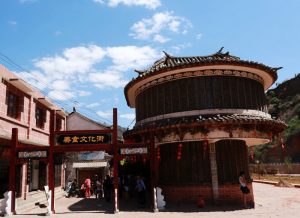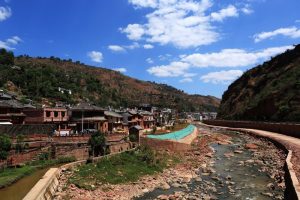
Heijing Ancient Town in Lufeng County, Chuxiong

Attractions Overview
With traditional folk residences, archways, and religion architectures, Heijing Ancient Town is well conserved in a traditional style as others do in China. Among them, 27 have been listed as county-level cultural relics protection units, and are known as “the treasure house of historical relics – the living fossil of Ming and Qing Dynasties”.
Chinese Name:楚雄禄丰黑井古镇
Chinese Pinyin: Chuxiong Lufeng Heijing Guzhen
English Name: Heijing Old Town in Lufeng County, Chuxiong
Attraction Type: Ancient Town
Seasons: Four seasons
Recommended Visiting Time: Half a day
Opening Time: All day long
Admission Fee: 30RMB/Person
Location: Lufeng County, Chuxiong Yi Autonomous Prefecture (楚雄彝族自治州禄丰县)
Why is Heijing Ancient Town So Special
Heijing Ancient Town has a long history. The unearthed relics of stones, potteries, and bronze wares have proved that as early as 3,200 years ago, ancestors of some minority groups already worked and multiplied on the land. During the Yuan, Ming and Qing Dynasties, 56 temples and nunneries were built, and steles of high historic and artistic values have been maintained. With traditional folk residences, archways, and religion architectures, Heijing Ancient Town is well conserved in a traditional style as others do in China. Among them, 27 have been listed as county-level cultural relics protection units, and are known as “the treasure house of historical relics – the living fossil of Ming and Qing Dynasties”.
Where is Heijing Ancient Town
Heijing Ancient Town is located in the northwest of Lufeng County, Chuxiong Prefecture, 200 kilometers from Kunming and 75 kilometers from Chuxiong.
How to Get There
- In Chuxiong Passenger Station, there are buses to Heijiang Town.
- It is very convenient to Heijing Station by train from Kunming Railway Station.
- After arriving in Lufeng County, car rental or self-driving is the recommended way to get to Heijing Ancient Town.
Introduction of Heijing Ancient Town

It was because of the salt that Heijing had become a well-known place. Its economics thrived; it became a trading hub luring people from different areas. Central mainland Chinese cultures and frontier ethnic cultures merged here. It became a cultural kaleidoscope representing diverse historical relics, ethnic cultures, architectural cultures, religious cultures, and cuisine which probably can be seen anywhere.
Now, the Heijing Ancient Town has long lost her glory of being the predominant salt provider of Yunnan Province. However, there are streets and alleys that still maintain a touch of the Tang and Song Dynasties. The residential architecture, stone inscription, carvings, pagodas, dolmens, performance stages, temples, and salt well are well preserved from the Ming and Qing Dynasties three to four hundred years ago. The Grand Courtyard of the Wu Family especially represents the perfectly preserved typical architectures of the Ming and Qing Dynasties. People from all over China as well as around the world come here.
Unlike the Lijiang Ancient Town with bridges and streams scatted all over in an orderly manner, the Heijing Ancient Town, which is less known, presents itself with an atmosphere of tranquility and slowness, bringing you back in history and escaping from this busy, bustling world.
Best Time to Go

The Heijing Ancient Town is suitable for tourism all year round. The area belongs to the subtropical monsoon climate, with warm spring and heavy drought, no summer heat, cool autumn, no cold in winter, small annual temperature difference, large daily temperature difference, and obvious dry and wet seasons. The annual rainy season is from May to October, and the annual average temperature is 15-21 °C.
Nearby Attractions
The Grand Courtyard of Wu Family
The Grand Courtyard of Wu Family is a typical Ming and Qing architecture that has been preserved to now. The Grand Courtyard of Wu Family was built in the 16th year of Daoguang in Qing Dynasty. It was expended in the 7th year of Xianfeng in Qing Dynasty and was built along the mountain. It is a “王(Wang)-shape”, with a unique layout. It consists of four patios with 99 houses. It, with a building area of 10,000 square meters, is well-connected and is one of the rare ancient residential buildings in Yunnan.
Feilaisi Temple
Feilaisi Temple is located at the hillside. Because of the steep mountain, looking from the bottom of the mountain, the whole temple is like a big bird entwined in the mountain. It seems to be flying and it also seems to have just landed from the sky. Therefore, Feilaisi Temple got its name. Looking down from the temple, the Longchuanjiang River(龙川江) passes through the deep canyon, and the town’s buildings are dotted on both sides of the river.
Heijing Confucius Temple
The Heijing Confucian Temple is located in the Longchuanjiang River Gorge(龙川江峡谷), Lufeng County, Chuxiong Prefecture. The Heijing Confucius Temple was built in the 45th year of Ming Wanli (1617). It was repeatedly destroyed by mudslides in the Qing Dynasty and was repeatedly rebuilt. The Confucius Temple is large in scale. There were 13 scholars (进士), which could show the prosperity of Heijing culture education.

 7 Days GolfingTour
7 Days GolfingTour
 8 Days Group Tour
8 Days Group Tour
 8 Days Yunnan Tour
8 Days Yunnan Tour
 7 Days Shangri La Hiking
7 Days Shangri La Hiking
 11 Days Yunnan Tour
11 Days Yunnan Tour
 6 Days Yuanyang Terraces
6 Days Yuanyang Terraces
 11 Days Yunnan Tour
11 Days Yunnan Tour
 8 Days South Yunnan
8 Days South Yunnan
 7 Days Tea Tour
7 Days Tea Tour
 8 Days Muslim Tour
8 Days Muslim Tour
 12 Days Self-Driving
12 Days Self-Driving
 4 Days Haba Climbing
4 Days Haba Climbing
 Tiger Leaping Gorge
Tiger Leaping Gorge
 Stone Forest
Stone Forest
 Yunnan-Tibet
Yunnan-Tibet
 Hani Rice Terraces
Hani Rice Terraces
 Kunming
Kunming
 Lijiang
Lijiang
 Shangri-la
Shangri-la
 Dali
Dali
 XishuangBanna
XishuangBanna
 Honghe
Honghe
 Kunming
Kunming
 Lijiang
Lijiang
 Shangri-la
Shangri-la
 Yuanyang Rice Terraces
Yuanyang Rice Terraces
 Nujiang
Nujiang
 XishuangBanna
XishuangBanna
 Spring City Golf
Spring City Golf
 Snow Mountain Golf
Snow Mountain Golf
 Stone Mountain Golf
Stone Mountain Golf













